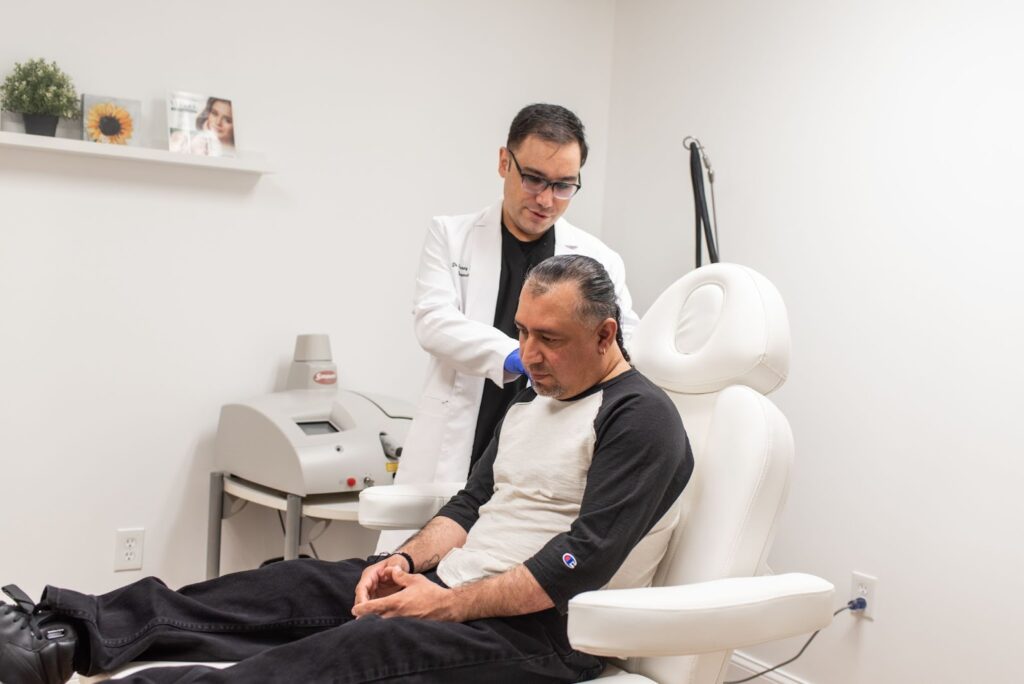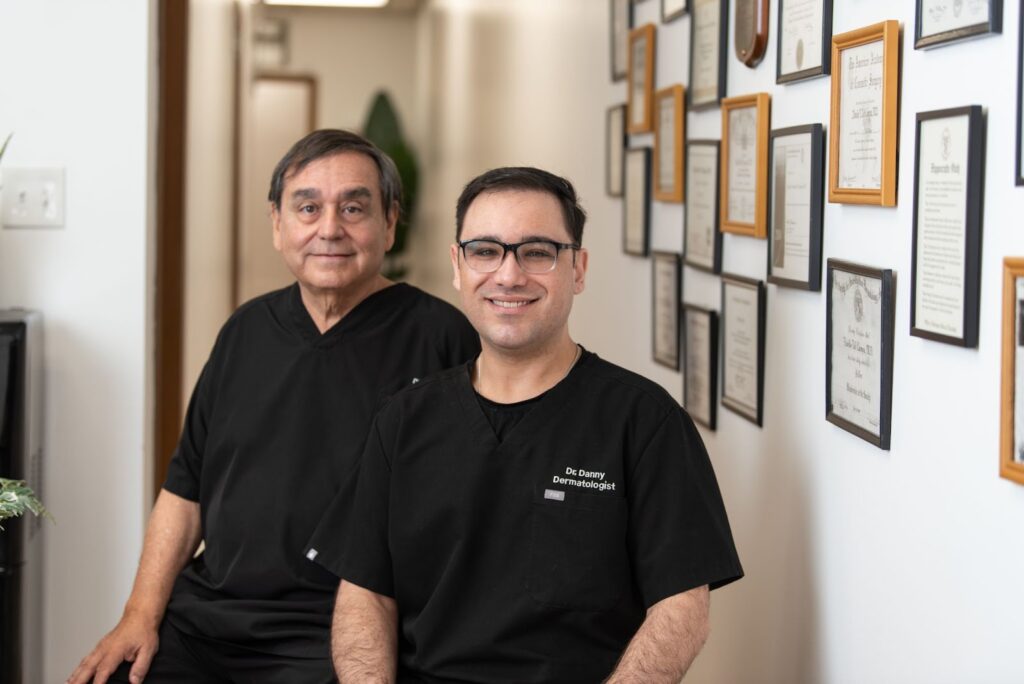May is Skin Cancer Awareness Month, a time to take a closer look at your skin and the ways you can protect it. At Chicago Skin Clinic, we believe awareness is a powerful tool. Knowing what to watch for—and what habits help reduce your risk—can make a real difference in your long-term health. This month, we’re shining a spotlight on melanoma, the most dangerous type of skin cancer, so you can take steps that help you stay protected.
What Is Melanoma And Why Does It Matter
You’ve probably heard the word before, but what is melanoma exactly? Melanoma is a type of skin cancer that begins in melanocytes—the cells that produce pigment. It can develop from an existing mole or appear as a new, unusual spot on your skin.
Unlike other skin cancers that tend to grow slowly and stay in one area, melanoma can spread more quickly to other parts of the body. That makes early detection critical.
Melanoma may be less common than basal or squamous cell carcinoma, but it accounts for the majority of skin cancer deaths. It can affect people of any age, gender, or skin tone. The risk increases with unprotected sun exposure, tanning bed use, and a family history of melanoma or atypical moles.
When caught early, melanoma is often treatable with minor procedures. When found late, it can require surgery, immunotherapy, or other more intensive treatment. That’s why keeping an eye on your skin and seeing your dermatologist regularly really does matter.
Melanoma Symptoms You Should Never Ignore
Melanoma doesn’t always look scary. In fact, it often shows up as something small or subtle. That’s why knowing what’s normal for your skin is important.
One of the most useful tools for spotting potential melanoma symptoms is the ABCDE rule:
- Asymmetry: One half of the mole or spot doesn’t match the other.
- Border: The edges are ragged, uneven, or notched.
- Color: The color is not consistent. You might see shades of black, brown, red, blue, or even white.
- Diameter: Larger than 6mm, or about the size of a pencil eraser.
- Evolving: Changes in size, shape, color, or behavior like itching or bleeding.
You might also notice a new spot that stands out from the rest of your moles—this is called the “ugly duckling” sign.
Spotting these details on your skin doesn’t guarantee cancer, but they do mean you should get checked. A quick visit to your Chicago dermatologist can give you clarity and peace of mind. If something needs treatment, early detection gives you more options and better results.
When To Get A Skin Cancer Screening
Self-checks are great—and necessary—but they don’t replace an expert’s eyes. Annual full-body skin exams are an important part of preventive care.
So, how do you know when to schedule one? Here’s a general guide:
- If you’re 30 or older, it’s time to start annual screenings.
- If you have a family history of melanoma or other skin cancer, start even sooner.
- If you have many moles or have noticed new or changing ones, don’t wait.
- If you’ve used tanning beds, had frequent sunburns, or have very fair skin, screenings are especially important.
And if something on your skin is persistently itching, bleeding, or growing, don’t delay. Get it looked at. It’s always better to be safe than sorry.
Our board-certified Dr. Danny and Dr. Del Campo provide thorough skin checks by examining every area, including the ones that you might not have thought of—like your scalp, back, palms, the bottoms of your feet, under the nails, or inside the mouth. We also take time to answer your questions and help you learn what’s normal for your skin type so you can leave with peace of mind, armed with knowledge on what to look for or the next steps, such as skin cancer surgery.

Everyday Habits That Help Lower Skin Cancer Risk
You can’t control every risk factor, but your daily habits have a big impact. Here’s what you can do to lower your chances of developing melanoma or other types of skin cancer:
- Wear sunscreen every day. Choose SPF 30 or higher, even on cloudy days and when you’re near windows indoors. Reapply every two hours if you’re outside.
- Avoid tanning beds. They expose your skin to concentrated UV rays that significantly raise your risk of melanoma.
- Cover up outdoors. Hats, sunglasses, and UV-protective clothing help shield your skin from the sun.
- Seek shade. Try to avoid direct sunlight between 10 AM and 4 PM, when UV rays are strongest.
- Know your skin. Monthly self-checks make it easier to notice new or changing spots.
You don’t have to avoid the outdoors altogether. You just need to be smart and consistent with your routine. Over time, these small steps can have a big impact on your skin health.
Other Types Of Skin Cancers To Be Aware Of This Skin Cancer Awareness Month
As mentioned earlier, melanoma is one of the deadliest of skin cancers, but it’s not the most common. Let’s briefly go over the other two main types of skin cancers so you can know what to look out for.
- Basal Cell Carcinoma (BCC): This is the most common form of skin cancer. It often looks like a pearly bump, a pink patch, or a sore that doesn’t heal. BCC usually grows slowly and rarely spreads, but it can damage nearby tissue if not treated.
- Squamous Cell Carcinoma (SCC): SCC may show up as a rough, scaly patch or a firm red bump. It can grow deeper into the skin and occasionally spread to other parts of the body. Like BCC, early treatment leads to better outcomes.
These types might be commonly seen as less serious than melanoma, but they still require care and attention. Skin cancer is skin cancer—regardless of the type—and catching it early is the most important step. Plus, every situation is different, and you shouldn’t assume you’re fine because it’s not melanoma.
If you have darker skin, it’s important to know that skin cancer can still occur. If you’re unsure what to look for, the American Academy of Dermatology has excellent image libraries that show how skin cancer can look across different skin tones.

Take Control Of Your Skin’s Health This May
Melanoma Awareness Month and Skin Cancer Awareness Month are more than a health observance. It’s a reminder to look at your skin, think about your habits, and schedule the appointments you’ve been putting off.
If you’ve never had a skin cancer screening—or it’s been more than a year—now is the time. If you’ve noticed a mole that looks different or a new spot you’re unsure about, come in and let us take a look. It’s a small step that can make a big difference.
Call Chicago Skin Clinic today to schedule a full-body skin exam with Dr. Danny or Dr. Del Campo. Whether you’re keeping up with routine care or have a specific concern, we’re here to support you with expert care in a professional, comfortable setting.
Your skin tells your story. Make sure it’s one that includes prevention, protection, and proactive care.
 SCHEDULE NOW
SCHEDULE NOW